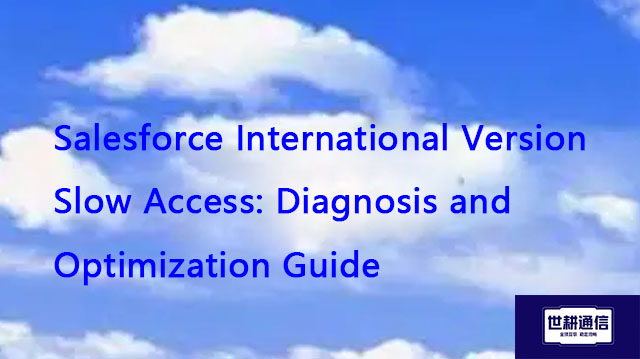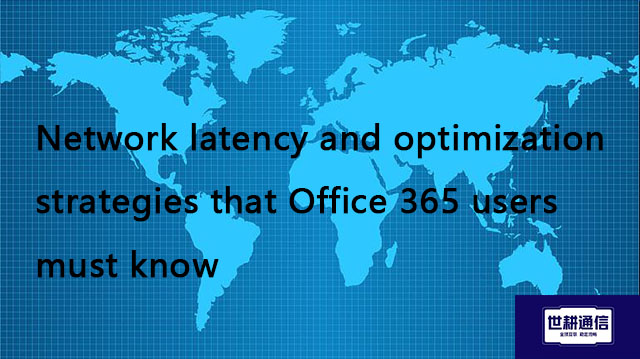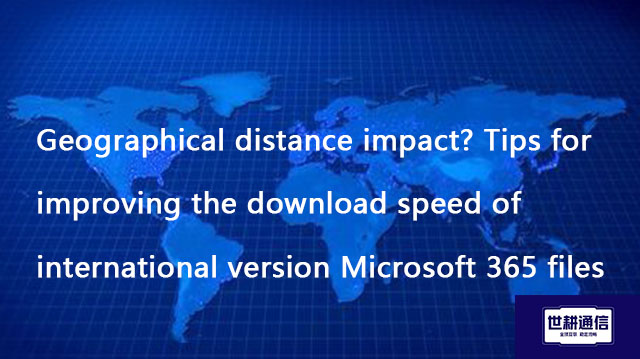Salesforce International Version Slow Access: Diagnosis and Optimization Guide??? Solution//Global IPLC service provider of Shigeng Communication
一、More than 100000 Chinese enterprise users worldwide are facing issues such as access lag and operational delays in Salesforce International, which seriously affect the efficiency and data security of CRM systems. This article combines technical principles and practical solutions to provide a complete diagnostic and optimization framework, helping enterprises systematically improve their access experience.
1. Deep analysis of the root cause of the problem
Geographic network latency
Salesforce's Asian nodes are mainly located in Japan, and Chinese users accessing through the public network need to go through multi hop routing. Test data shows that the average latency from domestic to Japanese servers exceeds 120ms, with packet loss rates as high as 5% -10%, leading to page loading timeouts and security risks
Traditional VPNs exacerbate latency: Enterprise VPNs need to be routed through company data centers, increasing network hops by over 30%
Terminal device and browser bottleneck
The Lightning experience relies heavily on JavaScript rendering and requires extremely high device processing capabilities. When the Octane rating of the browser is below 15000 (high-end devices usually>32000), there will be a graphics lag
Common performance killers: multi tag page parallelism (single tag consumes 300MB+memory), browser plugins (an average of 7 plugins cause page expansion by 40%)
Salesforce configuration defect
Enabling Aura debugging mode can reduce performance by 50%
Page design issue: A page containing over 100 fields, 5+related lists, or complex custom components, with rendering time exponentially increasing
2. Network layer optimization scheme
SD-WAN dedicated line acceleration
Core principle: directly connect to Salesforce Japan node through global backbone network, instead of public Internet routing. BGP dynamic routing is used between POP points and data centers, which has been tested to reduce latency by 60% and control packet loss rate below 0.1%
Deployment mode:
Enterprise CPE equipment → SD-WAN backbone network → Japan POP dedicated line → Salesforce instance
Support dual WAN backup (SD-WAN+MPLS), minute level failover
Effect: User access speed increased by 55%, data transmission reduced by 95% (Gzip compression+TCP optimization)
Proxy Server Transfer
Economic solution: Deploy a Japanese proxy server (recommended for the Tokyo region) and configure Nginx reverse proxy. Tested 2 million users require support from 4 8-core 32GB servers
Topology example: Domestic users → Domestic load balancing → Japanese proxy cluster → Salesforce API
3. Terminal and browser optimization
Equipment performance tuning
Perform Octane testing( https://chromium.github.io/octane/ )Less than 15000 requires:
Close backend applications to release CPU/memory
Disable non essential browser extensions (via) chrome://extensions )
Laptop connected to power (power-saving mode with 30% frequency reduction)
Best Practices for Browsers
Preferred Chrome: Lightning has the best compatibility and avoids using IE
Mandatory strategy:
Restart the browser every week to clear memory residue
Limit the number of tabs to no more than 15
Enable automatic updates (new version V8 engine speeds up by 20%)
4. Salesforce configuration optimization
Key setting check
Disable Aura debugging mode: Setup → Lightning Components → Cancel Enable Debug Mode
Close unused workflow rules and validation rules
Page architecture refactoring
Field simplification: Only display necessary fields through Profile configuration
Component layering:
Expected improvement in component type optimization plan
Move the detail component to the secondary tab/field and reduce it to less than 30. 40% faster rendering speed
Keep ≤ 3 main pages of related lists, and add tabs for the rest, reducing loading time by 200ms for each list
Custom component asynchronous loading or conversion to Lightning Action depends on complexity
Example transformation: Remove non core modules such as news/Twitter from the homepage and load them as needed
API Access Optimization
Using Bulk API to handle large amounts of data
Enable JSON format instead of XML (reducing volume by 70%)
5. Advanced architecture optimization
Hybrid CDN architecture
Renting servers on the West Coast of the United States (with the advantage of trans Pacific fiber optic cables) as the main source station
Build a distribution network through CloudFront, with edge nodes covering the Asia Pacific region
Intelligent DNS resolution: Chinese users → Japanese edge nodes, European and American users → Frankfurt nodes
Global Load Balancing (GSLB)
Multi Salesforce instance deployment (such as North America+Asia Pacific)
F5 or NS1 implements location-based request routing with latency optimization of 47%
Comparison of Optimization Effects (Typical Enterprise Cases)
Average latency, packet loss rate, and page loading time during the optimization phase
152ms before optimization 5.2% 8.4s
SD-WAN deployment 68ms 0.1% 4.1s
After configuration optimization, 65ms 0.1% 2.3s
By combining network layer acceleration, terminal optimization, and configuration simplification, enterprises can systematically solve Salesforce access bottlenecks. It is recommended to prioritize the implementation of SD-WAN and page reconstruction (fast results/low cost), and gradually promote CDN and global load balancing construction, ultimately achieving a 3-5 times increase in access speed in the Asia Pacific region and a user experience approaching that of a localized system.

二、Shigeng Communication Global Office Network Products:
The global office network product of Shigeng Communication is a high-quality product developed by the company for Chinese and foreign enterprise customers to access the application data transmission internet of overseas enterprises by making full use of its own network coverage and network management advantages.
Features of Global Application Network Products for Multinational Enterprises:
1. Quickly access global Internet cloud platform resources
2. Stable and low latency global cloud based video conferencing
3. Convenient and fast use of Internet resource sharing cloud platform (OA/ERP/cloud storage and other applications
Product tariff:
Global office network expenses | Monthly rent payment/yuan | Annual payment/yuan | Remarks |
Quality Package 1 | 1000 | 10800 | Free testing experience for 7 days |
Quality Package 2 | 1500 | 14400 | Free testing experience for 7 days |
Dedicated line package | 2400 | 19200 | Free testing experience for 7 days |







